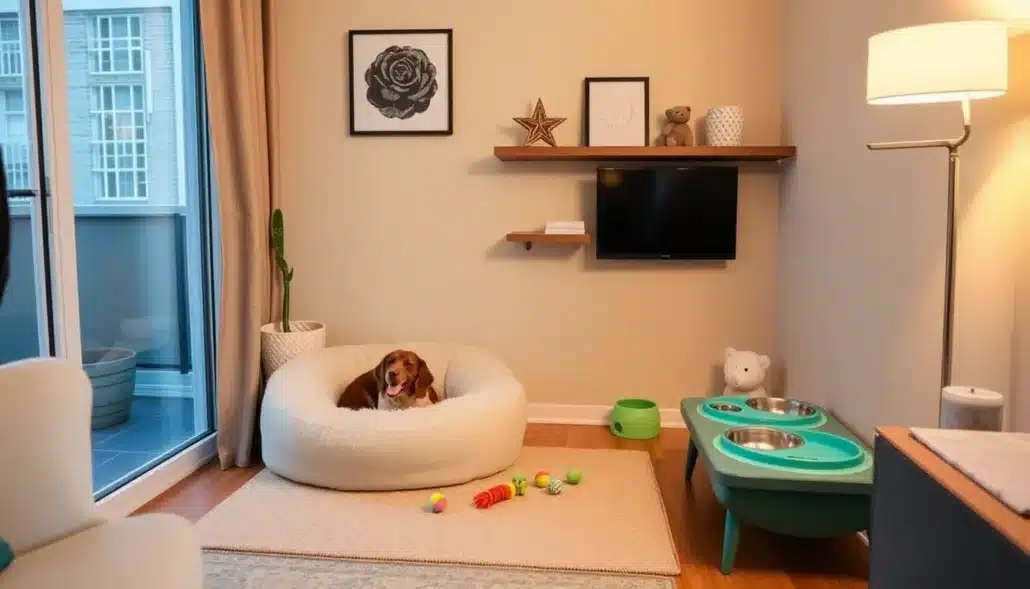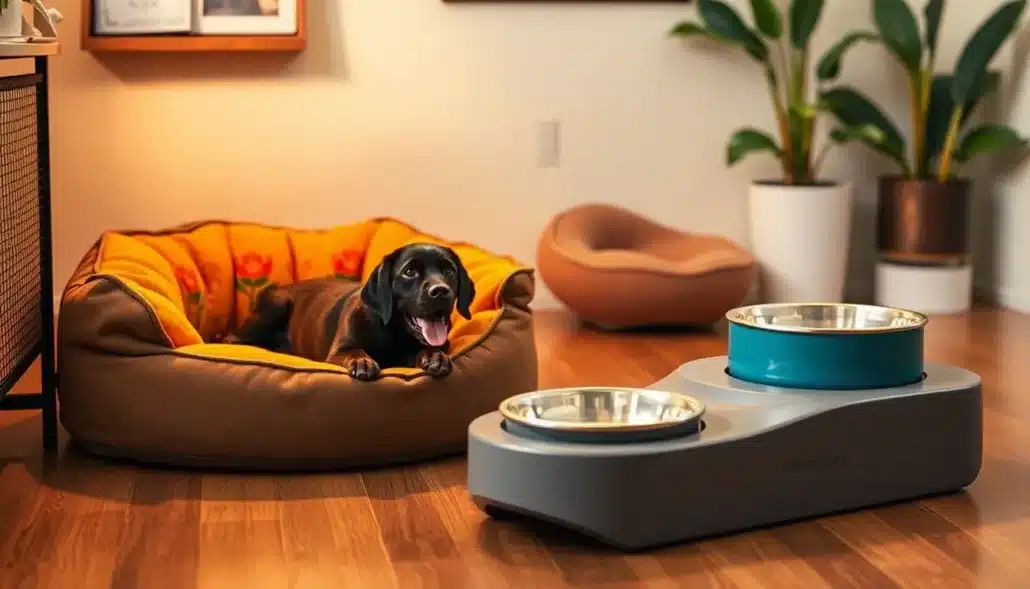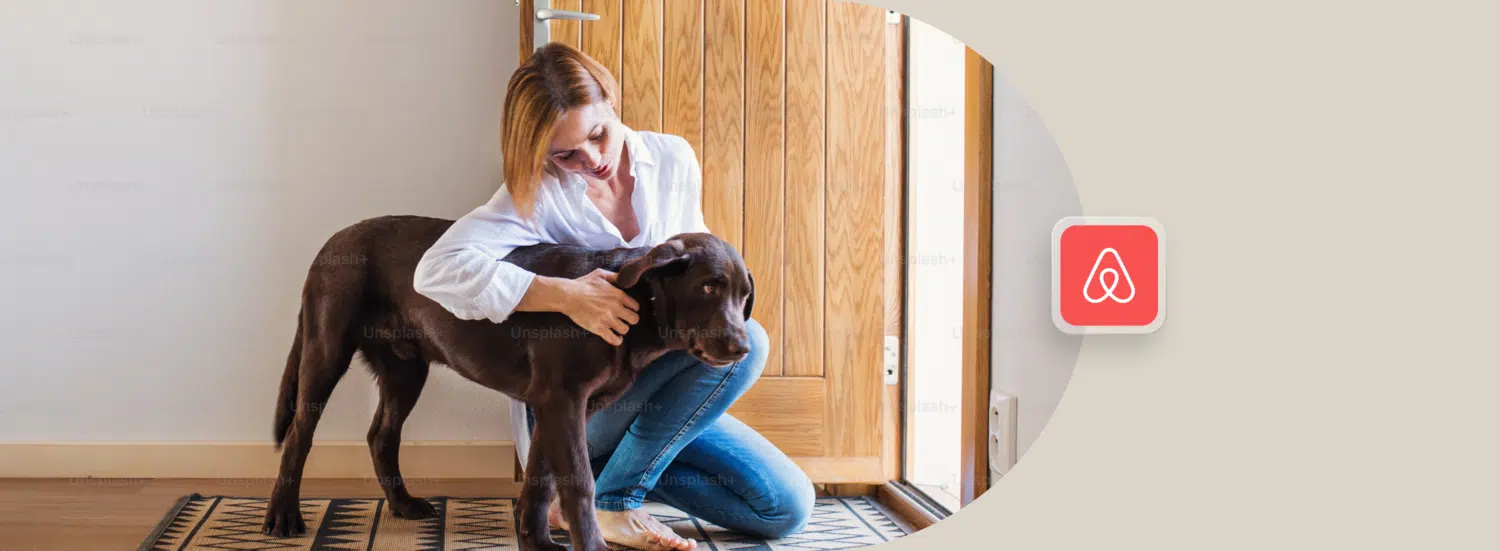Understanding the Pet-Friendly Airbnb Market
The pet-friendly travel industry has experienced remarkable growth in recent years, with the global pet-friendly hotel market projected to expand from $4.1 billion in 2024 to $4.62 billion in 2025, representing a robust compound annual growth rate (CAGR) of 12.7%. This surge in demand for pet-inclusive accommodations has created a significant opportunity for short-term rental hosts to tap into a thriving market segment.
As more people consider their pets as integral family members, the demand for pet-friendly Airbnbs and short-term rentals has surged. This trend is reflected in the financial benefits for hosts who welcome pets. Pet-friendly rentals command higher prices, with an average daily rate 9% higher than non-pet-friendly rentals in 2022 ($379 compared to $346). Moreover, these properties enjoy higher occupancy rates and generate more revenue, with pet-friendly rentals earning an average of $204 per available night, 24% higher than the $165 earned by non-pet-friendly rentals.
The financial advantages extend beyond just higher rates. Pet-friendly properties can potentially increase bookings and revenue by attracting a wider pool of guests. Some hosts charge additional “pet rent” of up to $30 per stay, along with higher security deposits to cover potential pet-related incidents. This premium pricing is justified by the limited supply of pet-friendly accommodations and the willingness of pet owners to pay more for the assurance that their pets are welcome.
Furthermore, the pet-friendly advantage isn’t limited to short-term rentals. A 2011 analysis of the condominium market found that pet-friendly landlords who place no restrictions on pet ownership enjoy an 11.6% rental premium over those who do not allow pets. This data underscores the significant financial potential for hosts who choose to welcome pets into their properties.
Pet owners often face challenges when traveling, such as finding suitable accommodations that can accommodate their beloved animals. Many hotels and traditional lodging options have strict no-pet policies, leaving pet owners with limited choices. This gap in the market has paved the way for vacation rental hosts to step in and provide a solution.
If you’re a property owner asking yourself, “Should I allow pets in my vacation rental?” or “Should I allow pets in my Airbnb?”, it’s essential to consider the potential benefits and challenges. By offering pet-friendly accommodations, you can address a significant pain point for travelers and potentially increase your bookings and revenue.
Benefits of Offering a Pet-Friendly Vacation Rental
Opening your doors to furry guests can bring numerous advantages to your short-term rental business. One of the most significant benefits is the potential for increased bookings and higher occupancy rates. Pet owners often struggle to find suitable accommodations, so by catering to this market, you can attract a wider pool of potential guests.
Additionally, pet-friendly Airbnbs have the potential to generate additional income through pet fees. Many hosts charge a modest fee for pets, which can help offset any additional cleaning or maintenance costs associated with hosting animal guests.
Another advantage of welcoming pets is the tendency for longer stays and repeat bookings. Pet owners may be more inclined to extend their vacations when they don’t have to worry about rushing back to their pets at home. This can translate to increased revenue and fewer gaps in your booking calendar.
Furthermore, offering a pet-friendly vacation rental gives you a competitive edge in the market. With fewer pet-friendly options available, your property is likely to stand out among the competition, potentially leading to more bookings and higher occupancy rates.
Preparing Your Property for Pet Guests
Before you start welcoming furry friends to your Airbnb, it’s crucial to assess your property for potential hazards and make necessary adjustments. Start by conducting a thorough inspection of your rental, looking for any areas that could pose a risk to pets, such as loose wires, toxic plants, or unsecured fences.
When it comes to furnishings, opt for durable and easy-to-clean materials that can withstand wear and tear from pets. Consider using stain-resistant fabrics for upholstery and choosing flooring options that are scratch-resistant and easy to maintain.
Creating a designated pet area within your rental can be a great way to make both pets and their owners feel welcome. This could be a corner of the living room with a comfortable pet bed, food and water bowls, and some toys.

Securing outdoor spaces is equally important. Ensure that any yard or patio areas are properly fenced to prevent pets from wandering off. This not only keeps pets safe but also gives their owners peace of mind during their stay.
Stocking basic pet amenities is a thoughtful touch that can greatly enhance the guest experience. Consider providing items such as food and water bowls, waste bags, and perhaps even a selection of toys or treats. These small gestures can make a big difference in how pet owners perceive your rental.
Establishing a Pet Policy
When it comes to adding pet-friendly to Airbnb, having a clear and comprehensive pet policy is essential. This policy should cover various aspects of pet stays, including size and breed restrictions, the maximum number of pets allowed, and rules about pets on furniture.
Consider implementing a cleaning policy that requires guests to clean up after their pets, both inside and outside the property. Communicate any fees or deposits associated with pet stays upfront to avoid misunderstandings.
Note: While Airbnb’s AirCover for Hosts offers $3M in Host damage protection, it’s important to clarify that this coverage extends to pet-related damages. AirCover includes protection for damage caused by guests’ pets, unexpected cleaning costs related to pet accidents, and even income loss if you need to cancel future bookings due to pet damage. This comprehensive coverage provides an extra layer of security for hosts who choose to welcome pets into their properties.
Your Airbnb pet policy should be easily accessible and clearly stated in your listing. Here’s an example of an Airbnb pet rules example you could use as a starting point:
“We welcome well-behaved pets in our Airbnb. A maximum of two pets are allowed per booking. Pets must be kept off furniture unless protective covers are used. Guests are responsible for cleaning up after their pets both inside and outside the property. A pet fee of $50 per stay applies. Any damage caused by pets will be deducted from the security deposit.”
Cons & Risks: Understanding Airbnb Policies
While allowing pets can bring benefits, it’s crucial to be aware of the potential drawbacks and risks associated with pet-friendly hosting:
- Property Damage: Pets can cause unexpected wear and tear, including scratched floors, chewed furniture, and accidents on carpets. While Airbnb offers Host damage protection as part of AirCover for Hosts, it’s essential to document any damage thoroughly.
- Increased Cleaning Costs: Pet hair, odors, and dander require extra cleaning and sanitization between guests, which can lead to higher maintenance expenses.
- Noise Complaints: Barking dogs or noisy pets can disturb neighbors or other guests, potentially leading to complaints and negative reviews.
- Allergy Concerns: Even with thorough cleaning, traces of pet hair or dander may linger, potentially causing allergic reactions in future guests.
- Liability Risks: If a pet injures another guest or damages someone else’s property, you could face legal issues.
- Limited Control Over Service Animals: Airbnb’s policy requires hosts to accept service animals, even if your listing doesn’t allow pets. You cannot charge additional fees for service animals.
- Emotional Support Animals (ESAs): Airbnb does not classify ESAs as service animals, and hosts are not required to accommodate them. However, this can lead to potential disputes with guests.
- Policy Enforcement Challenges: As Airbnb doesn’t enforce a standard pet policy, it’s up to hosts to clearly define and enforce their own rules.
- Potential Revenue Impact: While pet-friendly listings can attract more guests, they may also deter those with allergies or preferences for pet-free environments.
To mitigate these risks, ensure your pet policy is clearly communicated, consider charging a pet fee or deposit, and stay updated on Airbnb’s policies regarding pets and service animals. It’s crucial to understand that while you can set restrictions on pets, you cannot refuse service animals, as they are protected under Airbnb’s accessibility policy.
Service animals must be accommodated in all Airbnb properties without any additional pet fees, regardless of your general pet policy. This distinction is important, as it aligns with legal requirements and ensures equal access for guests with disabilities. However, emotional support animals (ESAs) are typically treated differently. In most jurisdictions, ESAs fall under general pet policies, allowing hosts the discretion to allow or deny them and charge pet fees, except in certain states with specific protections for ESAs.

By staying informed about these nuances in pet and service animal policies, you can ensure compliance with Airbnb’s rules and applicable laws while still maintaining control over your property’s pet-friendly status.
Strategies to Handle Noise Complaints in Pet-Friendly Airbnbs
Managing noise complaints is a critical aspect of hosting pets in your Airbnb. While many pets are well-behaved, occasional disruptions such as barking or other noises can lead to guest dissatisfaction or neighbor grievances. Implementing proactive strategies can help mitigate these issues and ensure a smooth experience for everyone involved.
Pre-Approving Pets Based on Owner Reviews
One effective strategy is to require pre-approval for pets before booking. Hosts can vet potential pet guests by reviewing the owner’s Airbnb profile and past reviews. If previous hosts have noted that the pet was quiet and well-behaved, it provides reassurance that the guest and their furry companion will be a good fit for your property. Include a clear note in your listing description, such as:
“Pets allowed by pre-approval only. Please provide details about your pet when booking.”
Set Clear Noise Rules
Establishing explicit noise-related rules in your pet policy is essential. For example, you can specify that dogs should not be left unattended at the property to prevent excessive barking. Here’s an example you can include in your house rules:
“Pets must not be left alone at the property unless crated, and excessive barking or disruptive behavior must be addressed immediately by the guest.”
Use Noise Monitoring Devices
Investing in noise monitoring tools can help you stay informed about potential disturbances without invading guest privacy. These devices monitor noise levels and alert you if they exceed a certain threshold, allowing you to address the issue promptly.
Communicate With Guests Proactively
If a noise complaint arises, contact the guest immediately in a polite yet firm manner. For instance:
“Dear [Guest Name], we’ve received feedback about noise levels from your pet. Please ensure that your pet remains calm and supervised to avoid further disturbances.”
This approach demonstrates professionalism while encouraging compliance with your Airbnb house rules.
Provide Pet Comfort Items
Sometimes pets become noisy due to stress or unfamiliar surroundings. Offering comfort items like chew toys, blankets, or calming sprays can help reduce anxiety and keep pets relaxed during their stay.
Partner With Local Pet Services
Collaborate with local dog walkers or pet sitters and provide guests with their contact information. This allows guests to arrange for professional care if they plan to leave their pets alone, reducing the likelihood of noise-related issues.
Leverage Airbnb Support for Persistent Issues
If noise complaints persist despite your efforts, escalate the matter through Airbnb’s support channels. Ensure you document all communication with guests and neighbors as evidence for resolving disputes.
By implementing these strategies, you can effectively manage noise complaints while maintaining a welcoming environment for both pet-owning guests and your neighbors.
Marketing Your Pet-Friendly Short-Term Rental
Once you’ve prepared your property and established your pet policy, it’s time to market your pet-friendly Airbnb effectively. Here are some enhanced strategies to optimize your listing and attract more pet-owning guests:
Highlight Pet-Friendly Features
Start by showcasing the pet-friendly amenities you offer, such as beds, bowls, toys, and any special features like a fenced yard or nearby dog park. Be specific about what you provide to help pet owners envision their stay.
Optimize Your Listing with Keywords
Use relevant keywords throughout your listing to improve its visibility in search results. Terms like “pet-friendly,” “dog-friendly,” or “cat-friendly” can help attract pet owners looking for suitable accommodations. Incorporate these keywords naturally into your property title, description, and summary.
Update House Rules
Clearly communicate your pet policy in the house rules section of your listing. Include details such as the maximum number of pets allowed, size restrictions, and any areas where pets are not permitted. This transparency helps set expectations and prevents misunderstandings.
Showcase Local Pet-Friendly Attractions
In your listing description, highlight nearby pet-friendly parks, walking trails, restaurants, and other attractions. This information gives potential guests an idea of what they can do with their pets during their stay and adds value to your offering.
Create a Pet-Friendly Guidebook
Develop a comprehensive digital guidebook for your property that includes a section dedicated to pet-friendly information. List local veterinarians, pet stores, groomers, and pet-sitting services. Also, include upcoming pet-friendly events and attractions in your area.
Encourage Photo Sharing
Invite guests to share photos of their pets enjoying your rental. These authentic images can be powerful marketing tools and help future guests envision their own pets in your space. Consider creating a dedicated social media hashtag for your property’s pet visitors.

Partner with Local Pet Businesses
Form partnerships with local pet businesses to offer exclusive deals or discounts to your guests. This not only enhances the guest experience but also helps you build relationships within the local pet community.
Optimize Your Property Tags
Use relevant and descriptive tags in your listing to categorize your property and make it easier for potential guests to find when searching for specific pet-friendly features or amenities.
Encourage Pet-Owner Reviews
After a guest’s stay, kindly ask them to mention their pet’s experience in their review. Positive reviews from pet owners can be incredibly persuasive for future guests considering your property. You might say, “We’d love to hear how [Pet’s name] enjoyed their stay!”
Seasonal Marketing
Consider offering special promotions or packages during pet-friendly seasons or events in your area. For example, you could create a “Dog Days of Summer” package or a “Howl-o-ween” special.
By implementing these strategies, you can effectively market your pet-friendly short-term rental, attract more pet-owning guests, and stand out in the competitive Airbnb marketplace. Remember to regularly update your listing and adapt your marketing approach based on guest feedback and changing trends in the pet-friendly travel industry.
Balancing Pet-Friendly and Pet-Free Periods
While marketing your short-term rental as pet-friendly can attract a significant segment of travelers, it’s important to consider how this might affect non-pet owners or those with allergies. To strike a balance and maximize your property’s appeal to all types of guests, consider implementing a flexible booking system that alternates between pet-friendly and pet-free periods.
Designating Pet-Free Booking Periods To cater to both pet owners and non-pet travelers, consider the following strategies:
- Designate specific weeks or months as “pet-free” periods
- Offer pet-free weekends alternating with pet-friendly weekends
- Create a booking calendar that clearly shows which dates are available for pets and which are pet-free
By implementing this strategy, you can attract a wider range of guests and potentially increase your overall occupancy rates. For example, you could allow pets only during specific dates, such as from November 19 to March 20, which aligns with the off-season for many vacation rentals.
Communicating Clearly in Your Listing
When marketing your property, be transparent about your pet policy and the availability of pet-free periods. Update your listing description to include information such as:
“We offer both pet-friendly and pet-free booking options. Please check our calendar for pet-friendly availability or contact us for pet-free dates.”
This clarity helps potential guests make informed decisions and reduces the likelihood of misunderstandings or negative reviews.
Creating Separate Listings
Another effective strategy is to create duplicate listings for your property – one that’s pet-friendly and another that’s pet-free. This approach allows you to:
- Maintain separate calendars for pet-friendly and pet-free periods
- Target different guest segments more effectively
- Preserve your reviews and Superhost status on your original listing
When creating a duplicate listing, you can add a note explaining that it’s an off-season listing that allows visiting pets, and direct potential guests to your main listing for your history of reviews.
Highlighting Deep Cleaning Practices
To reassure non-pet owners about the cleanliness of your property, emphasize your thorough cleaning protocols between guests. Consider including information such as:
- Use of hypoallergenic cleaning products
- Professional deep cleaning services after pet stays
- Air purification systems to remove pet dander and odors
Showcasing these practices can help alleviate concerns from guests with allergies or those who prefer pet-free environments.
By implementing these strategies, you can effectively market your short-term rental to both pet owners and non-pet travelers, maximizing your property’s appeal and potential bookings across different guest segments. Remember, the key is to create a welcoming environment for all guests while maintaining high standards of cleanliness and comfort.
Cat-Friendly Short-Term Rental Amenities

While dogs often come to mind when thinking about pet-friendly rentals, it’s important not to overlook our feline friends. Catering to cat owners can expand your potential guest base and make your rental stand out. Here are some cat-friendly amenities to consider:
- Scratching posts or pads to protect your furniture
- A litter box and scoop (guests can bring their own litter)
- Cat toys, such as small balls or interactive toys
- A cozy cat bed or blanket
- Elevated perches or window seats for cats to observe their surroundings
Remember to place these items strategically around your rental to create a cat-friendly environment that both felines and their owners will appreciate.
Dog-Friendly Short-Term Rental Amenities
For dog owners, certain amenities can make an Airbnb feel like a home away from home. Consider offering the following dog-friendly features:
- Durable, chew-resistant dog beds
- Elevated food and water bowls to reduce mess
- A selection of dog toys, including puzzle toys for mental stimulation
- Waste bags and a designated outdoor waste area
- Information on local dog parks, walking trails, and pet-friendly attractions

By providing these thoughtful amenities, you’ll create a welcoming environment for dogs and their owners, potentially leading to positive reviews and repeat bookings.
Ensuring a Positive Experience for All Guests
While catering to pet owners is important, it’s equally crucial to ensure a positive experience for all guests, including those without pets. Implement a thorough cleaning protocol between stays to remove any pet hair, dander, or odors.
Consider designating certain units or periods as pet-free to accommodate guests with allergies or those who prefer not to stay in a pet-friendly rental.
Provide information about local pet services, such as veterinarians, groomers, and pet stores. This can be incredibly helpful for pet owners and demonstrates your commitment to their needs.
Be prepared to address any issues promptly. Whether it’s a noise complaint or a maintenance issue related to a pet, quick and effective resolution is key to maintaining positive guest relationships.
Navigating Challenges in Pet-Friendly Hosting
While hosting pets can bring numerous benefits, it’s important to be prepared for potential challenges. Property damage is a common concern among hosts. Consider implementing a pet deposit or including pet-related damages in your security deposit policy.
Noise complaints can be another issue, particularly with dogs. Address this in your house rules, and provide clear guidelines on acceptable noise levels.
Allergies can be a concern for some guests. In addition to thorough cleaning, consider using hypoallergenic bedding and providing air purifiers in your rental.
Pet waste management is crucial for maintaining a clean and pleasant environment. Provide clear instructions and supplies for guests to clean up after their pets.
Expanding Your Pet-Friendly Offerings
As you become more comfortable with pet-friendly hosting, consider expanding your offerings. Partner with local pet-sitting or dog-walking services to provide additional value to your guests.
Create a comprehensive “pet-friendly guide” to the area, highlighting local attractions, services, and activities suitable for pets and their owners.
Consider offering premium pet-specific amenities, such as custom pet beds, gourmet treats, or pet-friendly welcome baskets.
If you manage multiple properties, create a range of pet-friendly options to cater to different preferences and needs. This could include properties specifically designed for small dogs, others suitable for larger breeds, and some catering to cats or other pets.
Offering a pet-friendly Airbnb or short-term rental can be a rewarding venture that opens up new opportunities for your short-term rental business. By understanding the market, preparing your property adequately, establishing clear policies, and providing thoughtful amenities, you can create a welcoming environment for pets and their owners. While there may be challenges along the way, the potential benefits in terms of increased bookings, revenue, and guest satisfaction make pet-friendly hosting a strategy worth considering for many vacation rental owners.




